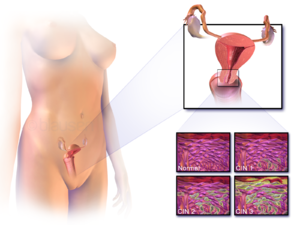Cancer of the cervix
| Cervical cancer | |
|---|---|
 |
|
| Location of cervical cancer and an example of normal and abnormal cells | |
| Specialty | Oncology |
| Symptoms |
Early: none Later: vaginal bleeding, pelvic pain, pain during sexual intercourse |
| Usual onset | Over 10 to 20 years |
| Types | Squamous cell carcinoma, adenocarcinoma, others |
| Causes | Human papillomavirus (HPV) infection |
| Risk factors | Smoking, weak immune system, birth control pills, starting sex at a young age, having many sexual partners |
| Diagnostic method | Cervical screening followed by a biopsy |
| Prevention | Regular cervical screening, HPV vaccines, condoms |
| Treatment | Surgery, chemotherapy, radiotherapy |
| Prognosis | Five year survival rates 68% (US) |
| Frequency | 3.4 million (2015) |
| Deaths | 238,600 (2015) |
| Classification |
· ·
|
|---|---|
| External resources |
Cervical cancer is a cancer arising from the cervix. It is due to the abnormal growth of cells that have the ability to invade or spread to other parts of the body. Early on, typically no symptoms are seen. Later symptoms may include abnormal vaginal bleeding, pelvic pain, or pain during sexual intercourse. While bleeding after sex may not be serious, it may also indicate the presence of cervical cancer.
Human papillomavirus (HPV) infection causes more than 90% of cases; most people who have had HPV infections, however, do not develop cervical cancer. Other risk factors include smoking, a weak immune system, birth control pills, starting sex at a young age, and having many sexual partners, but these are less important. Cervical cancer typically develops from precancerous changes over 10 to 20 years. About 90% of cervical cancer cases are squamous cell carcinomas, 10% are adenocarcinoma, and a small number are other types. Diagnosis is typically by cervical screening followed by a biopsy. Medical imaging is then done to determine whether or not the cancer has spread.
HPV vaccines protect against between two and seven high-risk strains of this family of viruses and may prevent up to 90% of cervical cancers. As a risk of cancer still exists, guidelines recommend continuing regular Pap smears. Other methods of prevention include: having few or no sexual partners and the use of condoms. Cervical cancer screening using the Pap smear or acetic acid can identify precancerous changes which when treated can prevent the development of cancer. Treatment of cervical cancer may consist of some combination of surgery, chemotherapy, and radiotherapy.Five year survival rates in the United States are 68%. Outcomes, however, depend very much on how early the cancer is detected.
...
Wikipedia
